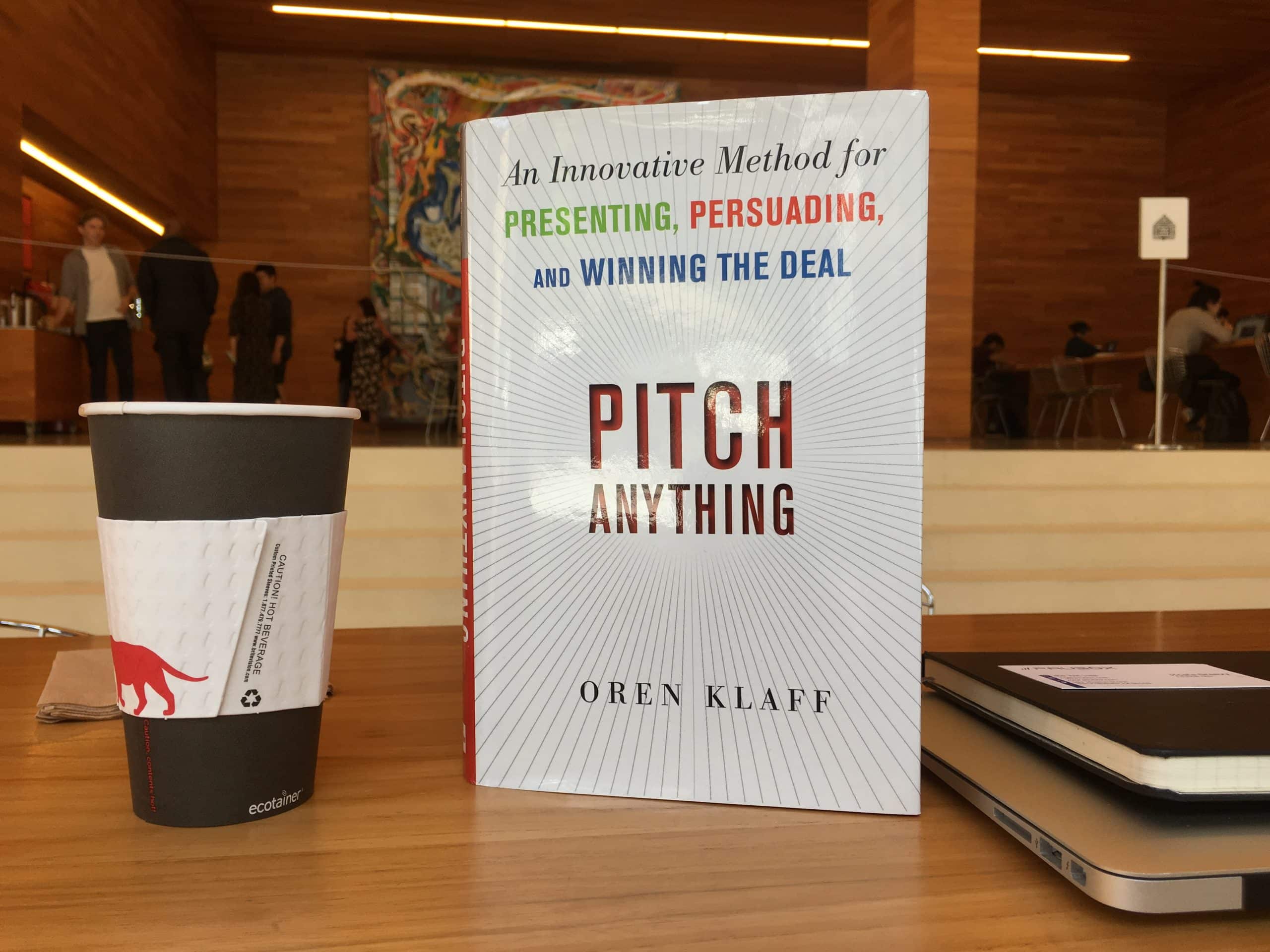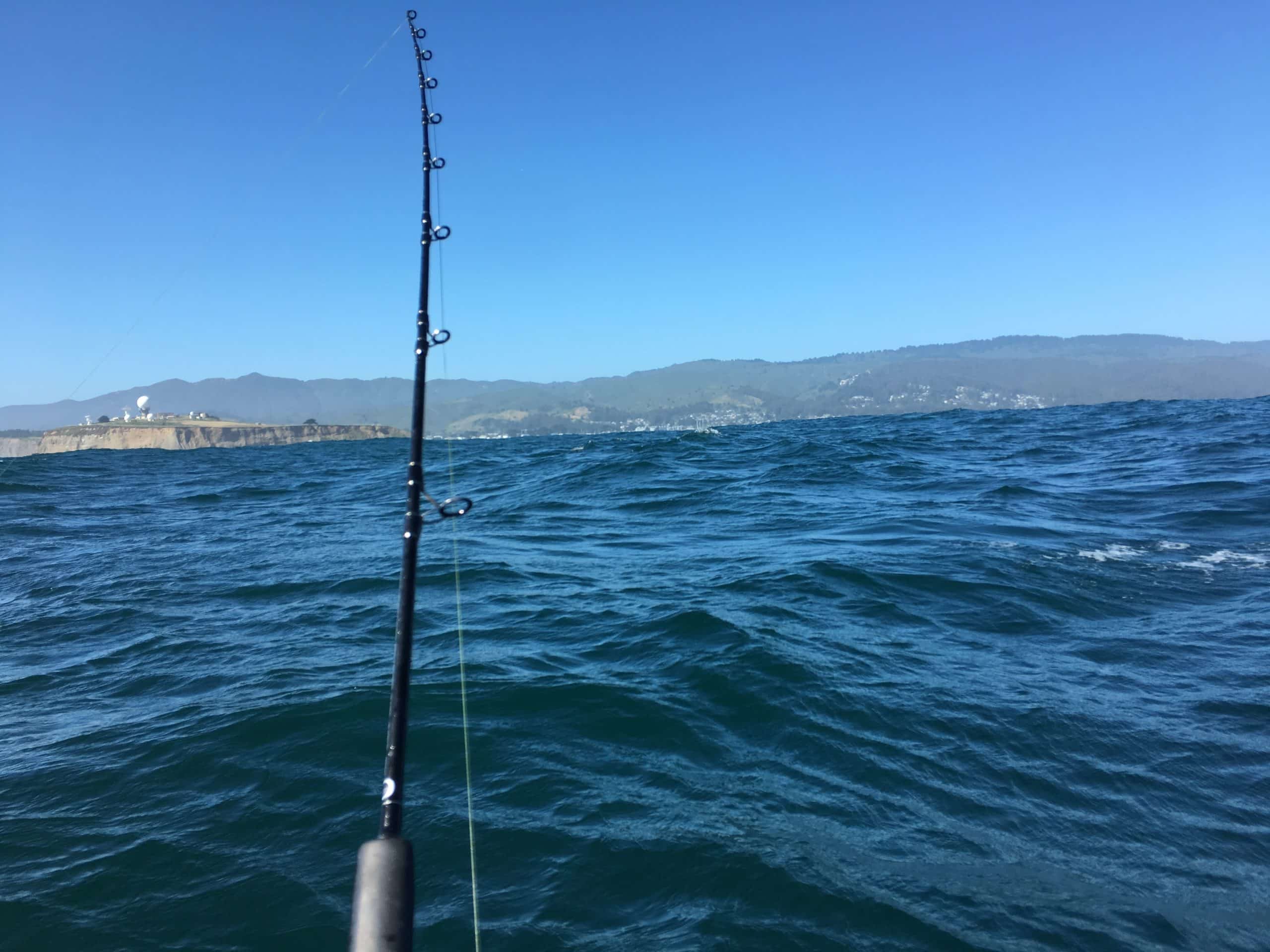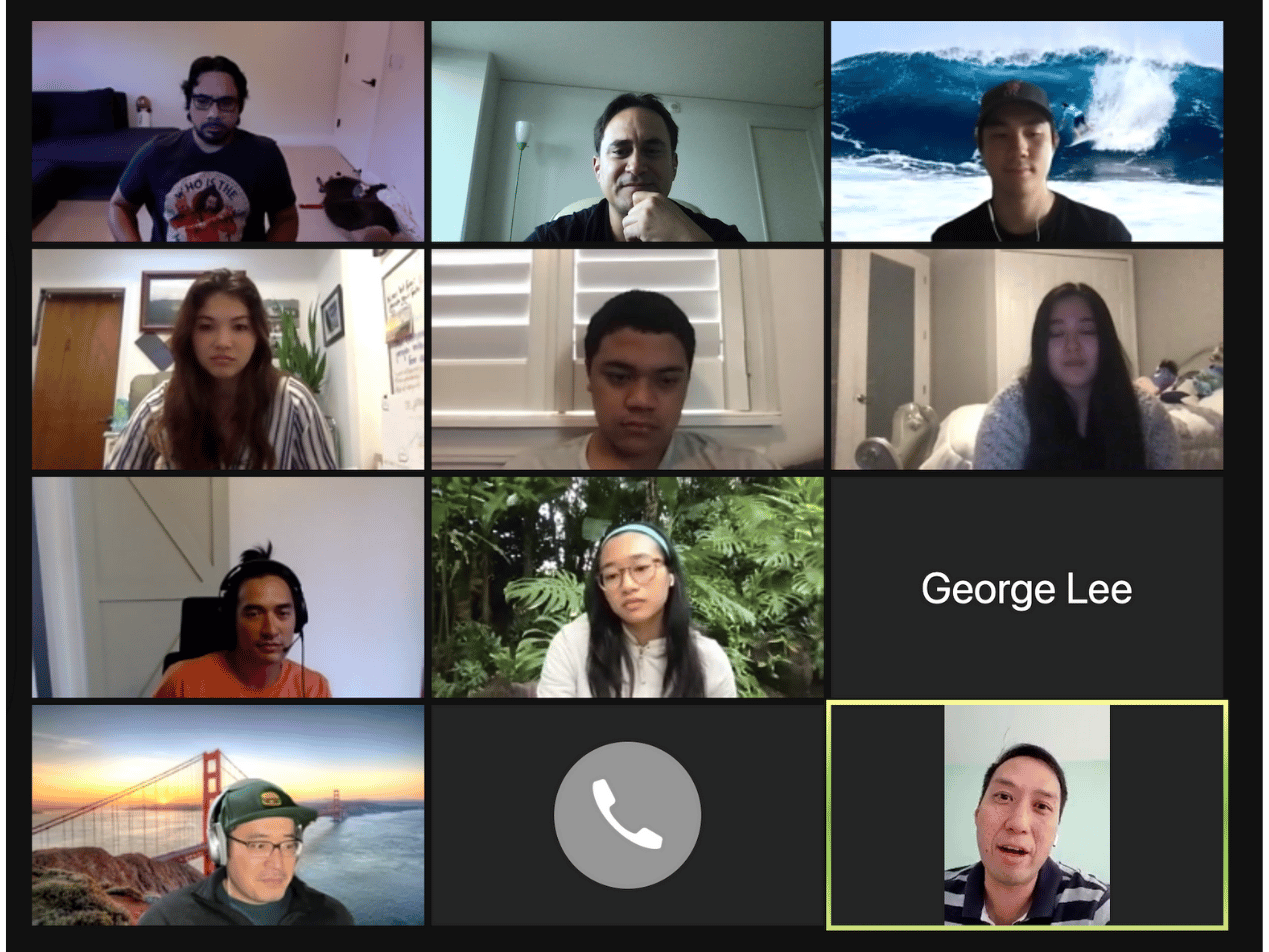
Finishing Pitch Anything in the LinkedIn building in SOMA.
Several weeks ago, Suraj Mehta from 500 Startups recommended I read Pitch Anything by Oren Klaff.
I ordered the book from my iPhone while we had lunch at Miss Saigon in SOMA.
Chapter 1: The Method
 Lunch at Miss Saigon in SF with Suraj Mehta
Lunch at Miss Saigon in SF with Suraj Mehta
Here are my takeaways from Chapter 1: The Method:
- "... a great pitch is not about procedure. It's about getting and keeping attention."
- Own the room with frame control.
- Drive emotions with intrigue pings and quickly get to a hookpoint.
- By default, people don't pitch well because of a flaw in the brain.
- Crocodile Brain, Mid-brain, and Neocortex
- "No pitch or message is going to get to the logic center of the other person's brain without passing through the survival filters of the crocodile brain system first."
- The croc brain has a short-sighted view of the world. "Anything that is not a crisis it tries to make as 'spam.'"
- "if there is one place in the brain you do not want your pitch to end up, it is the amygdala."
- STRONG:
- Set the frame
- Tell the story
- Reveal the intrigue
- Offer the prize
- Nail the hookpoint
- Get the deal
Chapter 2: Frame Control
 Getting pitch deck help from Rayfe Gaspar-Asaoka (Canaan Partners)
Getting pitch deck help from Rayfe Gaspar-Asaoka (Canaan Partners)
Here are my takeaways from Chapter 2: Frame Control:
- "Only one frame will dominate after the exchange, and the other frames will be subordinate to the winner."
- The less you say, the more effective you will be (re: frame control).
- "Understanding how to harness and apply the power of frames is the most important thing you will ever learn." (bold statement!)
- "When you fail to control the social frame, you probably have already lost."
- Own the frame to position yourself to reach an agreement with your prospect.
- "When you are responding ineffectively to things the other person is saying and doing, that person owns the frame, and you are being frame-controlled."
- "If you have to explain your authority, power, position, leverage, and advantage, you do not hold the stronger frame." (true dat!)
- Strong frames defeat rational arguments and trigger basic desires (croc brain).
- The three major types of opposing frames you'll encounter:
- Power frame. You'll see this often with people who have massive egos. Traits include arrogance, lack of interest, and rudeness.
- Time frame. Running long or beyond the point of attention shows weakness, neediness, and desperation.
- Analyst frame. Use the intrigue frame to derail this frame.
- To defeat the opposing frames and win the initial collision, take control via:
- Power-busting frame. Works like a charm against people with big egos. They never see it coming. Be prepared to use it immediately upon contact. Look for the first opportunity to perpetrate a small denial or act out some type of defiance (with a smile on your face). Defiance mixed with humor are key to seizing power and frame control. When you are defiant and funny simultaneously, the prospect will recognize and respect your game. Game recognizes game.
- Time constraining frame. Time frames are easy to defeat as long as you remain alert. "Running long or beyond the point of attention shows weakness, neediness, and desperation... When attention is lacking, set your own time constraint, bounce out of there."
- Intrigue frame.
- Prize frame. If the key decision maker isn't in the room when the meeting starts, hold your ground. Do not start. Wait 15 minutes and that person doesn't show, get up and politely leave. Do not give the presentation, do not leave brochures, do not apologize. Your time has been wasted, everyone in the room knows it and you don't have say anything. "Can you tell me more about yourself/your firm? We're picky about who we work with."
- Plowing- Always move forward, never stop moving, do not show self-doubt.
- "Just because you have frame control doesn't mead that someone won't push back. You just stay committed to your frame and keep it strong. You plow."
- "When attention is lacking, set your own time constraint, and bounce out of there."
- "The moment your audience does a "deep drill-down" into the minute details, you are losing control."
- "Nothing will freeze your pitch faster that allowing your audience to grind numbers or study details during the pitch."
- Force your audience to be analytical on its own time.
- "Keep the target focused on the business relationship at all times. Analysis comes later."
- Nonreactive state: When you see a person's mind wondering or thinking about something else. This can be corrected if you act quickly.
- "The most effective way to overcome the analyst frame is with an intrigue frame."
- Narrative (intrigue) and analytical information do not coexist. Use intrigue frame to evaporate the analyst frame.
- Intrigue frame: Tell a brief but relevant story that involves you. Keep their attention by not telling them how it ends until you're ready.
- The Intrigue story needs:
- It must be brief and relevant to your pitch.
- You need to be at the center of it.
- There should be risk, danger and uncertainty.
- Time pressure: Something bad will happen if action is not taken quickly.
- There should be tension.
- Consequences: Failure will not be pretty.
- Make sure to use the intrigue story as soon as you sense an analyst frame coming. Don't be afraid to make it very personal.
- An intrigue story breaks a analyst frame in an entertaining way and replaces analytical thinking with narrative discourse.
- "When you prize, you frame yourself as high value in the eyes of your target."
- "Who is the prize, or who is chasing whom, is one of the underlying social dynamics that influences most meetings."
- "Prizing is the sum of the actions you take to get your target to understand that he is a commodity and you are the prize." (100% agreed here in Silicon Valley)
- Curiosity and desire trigger the croc brain to chase you.
- "Money is never a prize; it's a commodity, a means for getting things done."
- Never let the prospect change the agenda, the meeting time, or who will attend. Withdraw if the prospect wants to force this.
- Try this one: "So many buyers, yet only one of me. How are you going to compete for my attention." (Do not end it with a question. It's a statement.)
- "Make the target perform a legitimate task to earn the deal."
- Money can't do anything without you. Money needs you.
- Always lead with something like this: "I'm glad I could find the time to meet with you today. And I do have another meeting right after this. So let's get started."
- "Remember, small acts of defiance and denials, combined with humor, are extremely powerful in maintaining your frame control and in reinforcing your high status."
Chapter 3: Status
 Clearing my head out on the water
Clearing my head out on the water
Here are my takeaways from Chapter 3: Status:
- Like it or not, fitting in and having high social status are essential.
- "if you hold high social status, even on a temporary basis, your power to convince others will be strong, and your pitch will go easily."
- "If you do not have high status, you will no command the attention necessary to make your pitch heard."
- "Do not underestimate the importance and value of status to your overall success."
- Avoid beta traps at all costs.
- "A beta trap is a subtle but effective social ritual that puts you in the low-status position and works to keep you there, beneath the decision maker you have come to visit, for the entire duration of the social interaction."
- "the lobby serves to demote you from the moment you arrive and keep you demoted throughout your visit."
- "In general, public spaces are the most deadly beta traps and should be avoided. For a real pitch, coffee shops are an absolute last resort."
- On the floor at trade shows and conventions are other classic beta traps. Pitch anywhere except on the floor of the convention hall.
- The Master of Beta Traps is Walmart.
- "If you wish to elevate your social value in any given situation, you can do so by redirecting people into a domain where you are in charge." This is called local star power.
- Quick judgements, like it or not, are made on your wealth, power, and popularity.
- "The first thing you do when you meet with a target is to establish local star power."
- "The faster you grab status, the more is available for you to take."
- "If you think you'll start a meeting from the beta position, always be on time for the appointment."
- "When you are late, you are giving away power."
- "Momentum is key. Create hight status immediately."
- "Choose a frame, and force a collision at the most opportune moment- and do it early. The more you wait, the more you reinforce the status of your target."
- Idle social banter does nothing for you. Do not do it.
- Once you leave the meeting, the local star power is gone. You'll have to re-establish it again at the next meeting.
- "Global status (wealth, power, popularity) is fixed. It's only situational status that you can grab and control."
- "One of the best ways to get a customer to confirm your alpha status is to make him defend himself in a light-hared way."
- Don't forget to use: "Remind me again why in the world I want to do business with you?" and "Have you ever done a deal this large before?"
Chapter 4: Pitching Your Big Idea
 A view of the Bay Bridge on a morning run
A view of the Bay Bridge on a morning run
Here are my takeaways from Chapter 4: Pitching Your Big Idea:
- No company in America should let its executives pitch for an hour.
- 20 minutes into a presentation, the brain already starts forgetting things it's already learned.
- The time-constraint pattern: "Let's get started. I've only got about 20 minutes to give you the big idea, which will leave us some time to talk it over before I have to get out of here." (Memorize this)
- "Anything can be pitched in 20 minutes by a pro."
- What's important isn't mastery over the details but mastery over attention and time.
- The pitch should have four phases.
- Phase 1: Introduce Yourself and the Big Idea (5 minutes)
- "The very first thing you need to do- even before you think about explaining your idea- is to give people your background."
- Only big wins are worth talking about. Stop with one great thing.
- "Get your track record on the table, and do it fast, clean, and problem-free."
- A reminder of the obvious: "Nobody wants to invest time or money into an old deal that has been sitting around."
- "The target needs to know that you are pitching a new idea that came to life from a pattern of forces that you recognized, seized, and are now taking advantage of."
- Use the Three-Market-Forces Pattern: Economic forces, Social forces and Technology forces.
- "The backstory of the idea is always more interesting to the target. Once this story is told, everything you say in your pitch will be legitimized by it."
- To craft a backstory, think of how it came to be where it is today as opposed to how you found it.
- "By starting your pitch with the three market forces, your idea now enjoys a prominence that it did not have before."
- Frame your deal in a way that explains the force behind its evolution.
- "Your target needs to understand the forces that are pushing your deal and to understand that your success is inevitable and imminent as a consequence of these greater forces."
- "Your brain grows accustomed to things that are not changing, and they effectively vanish."
- Change blindness is overcome by the 3 market forces technique.
- Prospects simply do not like old deals.
- Use Geoff Moore's Idea Introduction Pattern to introduce the big idea.
- "The rudimentary model of how attention works goes like this: We notice things that have movement through space and time because they are likely to be important."
- Idea Introduction Pattern: Here's what it is, here's who it's for, and here's who we compete with. Popularized by Geoff Moore, author of Crossing the Chasm.
- "There's plenty of evidence to suggest that the more you talk about your background, the more average it becomes because the target is hardwired to average information about you, not add it up."
- Phase 2: Explain the budget and secret sauce (10 minutes)
- "The opportunities to scare the croc brain seriously multiply when you start to explain how stuff works."
- "All the important stuff must fit into the audience's limits of attention, which for most people is about 20 minutes."
- Attention is given when novelty is high and wanes when novelty is low.
- When both desire (Dopamine) and tension (Norepinephrine) are present, the prospect is paying close attention to what's at hand. In other words, offer a reward and then take something away.
- "Dopamine motivates the human body to act on some things and ignore others."
- When the prospect knows enough to understand you big idea, curiosity ends and your pitch is effectively over.
- Tension introduces real consequences to social encounters, which therefore signal importance.
- Create tension in your pitch, don't be afraid of it.
- "A pitch narrative can be thought of as a series of tension loops,. Push then pull. Create tension. Then resolve it."
- "When there's no tension between you and the target, there's no interest in what happens."
- Understand that what's happening in your mind is not what's happening in the prospect's mind.
- Focus on demonstrating excellence in budgeting, which is hard to do. Any simpleton can put together outsized revenue projections.
- Briefly describe your secret sauce, the unfair advantage you have over others.
- Phase 3: Offer the deal (2 minutes)
- "In clear and concise terms, tell the audience exactly what you will be delivering to them, when it will be delivered, and how."
- "Keep it brief but rich in high-level details so there is no question as to what the audience is going to get."
- Phase 4: Stack frames for a hot cognition (see next chapter)
Chapter 5: Frame Stacking and Hot Cognitions
 Over a mile out at Half Moon Bay
Over a mile out at Half Moon Bay
Here are my takeaways from Chapter 5: Frame Stacking and Hot Cognitions:
- To avoid cold, reasoned analysis, manufacture hot cognition by stacking frames.
- "When the target starts getting analytical and cold, it's time for the four-frame hot cognition stack to enter the pitch."
- Stack these four frames to trigger the prospect's croc brain:
- Hot Cognition 1: The intrigue frame.
- Hot Cognition 2: The prize frame.
- Hot Cognition 3: The time frame.
- Hot Cognition 4: The moral authority frame.
- The Intrigue Frame.
- "People like to hear stories about interesting and slightly eccentric characters."
- "The intrigue frame makes a lot of sense when you think about why the target is sitting there listening to your pitch."
- People want to know how you faced obstacles and overcome them.
- Man in the jungle formula: Put a man in the jungle. Have beasts attack him. Will het get to safety?
- Re: man in the jungle formula, it's not what happens to you that makes it interesting, it what you do about the situation.
- "To hold intrigue and make it [man in the jungle] work as an emotional event, a hot cognition, I don't complete the story... and instead move to the next frame in the stack: the prize frame."
- The Prize Frame.
- The prize frame positions you as the most important party in the deal.
- Successful prizing flips the frame.
- "Can you tell me why we would enjoy working with you?" (Great prize frame question)
- "The prize frame is a hot cognition that signals the target's croc brain that you are strong, you are not needy, and you are not going to supplicate for a deal."
- Say these words to yourself to activate the prize frame:
- I am the prize.
- You are trying to impress me.
- You are trying to win my approval.
- The prize frame does not necessarily rely on words and explanations, it's more about strength of conviction about who is really the prize in the room.
- The Time Frame.
- "The addition of time pressure to a decision-making event reduces decision quality."
- Scarcity bias: The potential loss of a deal trigger fear in the brain.
- The Deal train: They stop at the station, on-board investors and set a departure time. Once it leaves the station, it's gone.
- "Every single person knows what you're talking about when you say the train is leaving the station at such and such date and time."
- The Moral Authority Frame.
- "To create a desire in the target's mind and to go on from the pitch to the hookpoint, every presenter has to use hot cognitions to create wanting and desire."
- The doctor frame may be the most powerful moral authority frame in the world.
- "A hot cognition- or a series of hot cognitions- is a fast method for getting the target's croc brain to want you and your big idea."
- After you pitch, does the prospect want to buy, join the team, or invest? (Great indicators of how well it went)
- Hot cognition: A certainty from within of just knowing something that comes through feeling it. Intuition.
- Cold cognition: Reaching a conclusion of something being bad or good by having evaluated it.
- "You can trigger a hot cognition instantly, but cold cognition can take hours or days."
- A hot cognition, which may be the anticipation of a large financial gain, is emotionally compelling to a prospect.
- "Reality isn't waiting to be discovered- it's waiting to be framed."
- Stack four frames quickly after each other to create hot cognition in the prospect. Help them discover a wanting.
Chapter 6: Eradicating Neediness
 Deck feedback from Suraj Mehta at 500 Startups
Deck feedback from Suraj Mehta at 500 Startups
Here are my takeaways from Chapter 6: Eradicating Neediness:
- Neediness is the #1 deal killer.
- Neediness is terrible for frame control, erodes status and ices over hot cognitions.
- "No investor wants to work with a needy company run by an entrepreneur who is almost out of cash!"
- Neediness triggers uncertainty, which then causes a person's croc brain to take over (in a bad way).
- Phrases of Neediness:
- "Do you still think it's a good deal?"
- "So, what do you think?"
- "We can sign a deal right away if you want us to."
- "Plain and simple, neediness equals weakness."
- "When we want something that only the target can give us (money, an order, a job,) we set the stage for neediness."
- Go into every social interaction with a strong time frame that you can use at any moment.
- The basic formula to smash Neediness:
- Want nothing.
- Focus only on things you do well.
- Announce you intention to leave the social encounter.
- "The willingness to withdraw demonstrates a self-control, strength, and confidence that most targets will greatly admire."
- The 3 Rules of Tao:
- Eliminate your desires.
- Be excellent in the presence of others.
- Withdraw.
- When you finish your pitch, deny your audience by pulling away.
- "I don't need these people; they need me. I am the prize."
- "I think you guys are interesting, but are you really the right investor?"
- Never be needy!
Chapter 7: Case Study: The Airport Deal
 Pitching our HIPAA Email API with Scott Wong
Pitching our HIPAA Email API with Scott Wong
Here are my takeaways from Chapter 7: The Airport Deal:
- "My research had shown that the small talk at the beginning of a pitch typically was fruitless."
- Focus on a unique theme and storyline- a compelling human drama.
- Every pitch should tell a story.
- Eliminating Neediness:
- Remove your desires.
- Be excellent in the presence of others.
- Withdraw at the crucial moment.
- The brain is hard-wired to achieve status, not money.
- "I'm okay with the notion that our plan is too bold and that we aren't right for each other." (Wow what a hook)
- The brain constantly calculates how each social encounter will increase or decrease its status.
Chapter 8: Get in the Game
 Practicing my pitch on the walk to work
Practicing my pitch on the walk to work
Here are my takeaways from Chapter 8: Get in the Game:
- Every croc brain responds the same:
- When something is boring: Ignore it.
- When something seems dangerous: Fight/run.
- When something is complicated: Radically summarize (causing information loss) and pass it on in severely truncated form.
- Respect the croc brain by introducing it to a game, then invite others to play with you.
- "Frames are psychological referencing systems that all people use to gain a perspective and relevance on issues.
- Frames impact judgement and change the meaning of human behavior.
- When you correctly set the frame, you control the agenda of the pitch.
- "Humor, fun, and light-heartedness are crucial components of every pitch."
- Two principal insights in social dynamics pervade within the book: Generate hot cognition within the croc brain and always be on alert for opposing power frames and quickly win them with better, stronger frames.
- Using humor is not used to relieve tension. Instead, use it to signal that although tension exists, you are so confident that you can be playful.
- Don't forget: "People who have lots of options are not uptight and they don't take themselves too seriously."
- Weak frames and unimportant details bounce off strong frames.
- Getting Started:
- Step 1: Learn to recognize beta traps and how to step around them.
- Step 2: Use 4 basic frames to avoid beta traps.
- Step 3: Identify and label social frames.
- Step 4: Practice frame collisions with safe targets. Don't forget to use humor and a soft touch.
- Step 5: Conflict and tension. Push and Pull. These are desired.
- Step 6: Frame control can't be forced.
- Step 7: Work with other frame masters. Keep it simple. Stick to a few frames that work for you. Avoid complexity.
- Learn and practice frame control at every opportunity. Make sure to have fun!
Subscribe to Paubox Weekly
Every Friday we'll bring you the most important news from Paubox. Our aim is to make you smarter, faster.

 Hoala Greevy
Hoala Greevy



